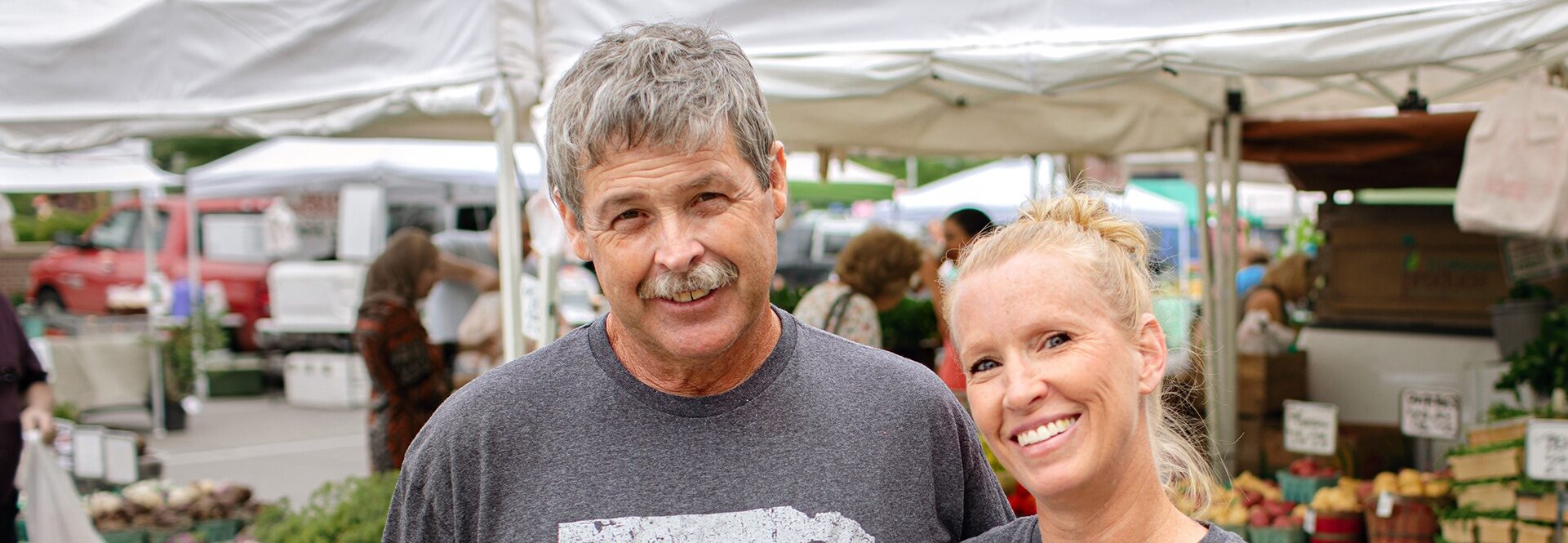Farmers Markets Are Hubs for Local Food
Farmers markets across the country serve to build stronger community connections through fresh food.

Direct-to-consumer food sales totaled $2.9 billion in 2020, and on-farm stores and farmers markets accounted for $1.7 billion, according to the United States Department of Agriculture.
Chip Ross, wellbeing program manager at Syngenta, suggests that growers open themselves up to the idea of selling at farmers markets.
“It’s certainly something to put yourself out there and build a positive reputation about your produce,” Ross says.
Farmers markets are strong contenders for the future of local food, with more than 8,000 markets selling directly to consumers across the U.S. each season. They benefit local communities by providing fresh produce at an affordable price and empowering consumers to understand where their food comes from.
Heading to Market
Donna and Ed Welchert of Ed Welchert Produce in Ft. Calhoun, Nebraska, have attended the Omaha Farmers Market every Sunday from May to October for 30 years to sell their fresh vegetables.
“We attend the farmers market when we’re growing plants so we can sell them to people and they can start their own gardens,” says Donna, partner and marketing manager. “Once the vegetables start coming in, we sell both plants and vegetables until later in the season.”
Each Sunday, the Welcherts spend three hours removing their produce from the truck and setting up their booth. They require a 10×20 double booth because they grow and sell a large variety of produce including lettuce, peppers, green onions and potatoes. While the weekly setup requires more labor, joining the Omaha Farmers Market is a fairly simple process.
“They make it easy; everything is online. We pay an annual fee for our booth, around $1,100, and we’re in the same exact spot every week, every year, so everybody knows how to find us,” Donna says. “We’ve gained tons of customers who have been with us for years.”
Becoming a Vendor
Maggie Winton, event marketing coordinator at VGA Fundraising and Events, assists in coordinating vendors for the Omaha Farmers Market, which includes creating, collecting and sorting applications.
“We typically give vendors about six weeks between when we send out the applications and when season vendor applications are due,” she says. “During this time period, we categorize our vendors in different ways.”
The two categories are season vendors and weekly vendors. Season vendors have the same spot in the market all season long. Weekly vendors may not be in the market every week, so they’re rotated based on space availability.
On average across the country, farmers market booth fees vary based on the location, size or popularity of the market. Daily booth fees can range from $20 to $50, in addition to permit and insurance fees.
The Omaha Farmers Market has two locations: Old Market and Aksarben Village. “Weekly vendors at the Old Market location typically pay a $35 fee each week they participate in the farmers market and a $40 per week fee for Aksarben Village, since it’s a slightly larger market,” Winton says. “Season vendors pay between $585 and $665 for a single booth.” The market hosts 90 vendor spaces on Saturdays and 120 on Sundays; they also accept SNAP and other food assistance programs.
I think that these spaces are so integral to the longevity of our farming communities, and our local growers and businesses. I feel really proud to be involved, even if I contribute just a small part.
Reaping Rewards, Braving Weather
The Welcherts see many benefits associated with attending farmers markets, such as the opportunity to interact directly with customers in-person and through social media; it helps build community connections.
“I do believe our community connections, whether it’s been customers or the market in general, have improved over the years because of social media,” Donna says. “People are able to reach right out to us and get to know the farmer.”
Another major benefit is cash flow. The Welcherts say their income from the farm is made through selling at the Omaha Market, but some years are better than others.
“The income level always changes. It changes with the weather, and a crop may or may not come out good for you,” she says. “We’ve had bad potato years, we’ve had bad onion years, that’s always going to be a thing with farming. But we make a pretty decent living just by participating in the farmers market.”
In addition to the weather’s effect on crop yields, for growers participating in farmers markets, it also affects foot traffic and can impact sales. One common disadvantage is a lack of overhead coverings for booths, which means harsh weather may damage booths, displays and products.
Zoua Lo, owner of Lu’s Flowers and Vegetables, says she sees both good and bad days, and it’s largely dependent on the weather.
“If it’s a rainy day, we don’t have any customers. If it’s a nice day, we have lots of customers,” Lo says.
Stacking It High
Donna Welchert says when attending a farmers market, always bring ample produce – people appreciate options and enjoy looking through stacks of produce to find their perfect vegetable.
“A long time ago, we were told to ‘stack it high, and watch it fly’,” she says. “We live by this motto, and we found that people want to pick out their own stuff. They want to look through the peppers and say, ‘This is the one I want.’”
Lo believes the key to success at a farmers market is simply talking to customers and fellow vendors, because being friendly and connecting with the community builds long-lasting relationships.
As the Omaha Farmers Market celebrates its 30th year, it’s clear that it has had a great impact on the community.
“I think that these spaces are so integral to the longevity of our farming communities, and our local growers and businesses,” Winton says. “I feel really proud to be involved, even if I contribute just a small part.”
4 Min Read
- Farmers markets generate nearly $2 billion annually.
- Many growers earn a solid living from farmers market sales.
- Providing lots of produce for consumers to pick through can increase sales.























